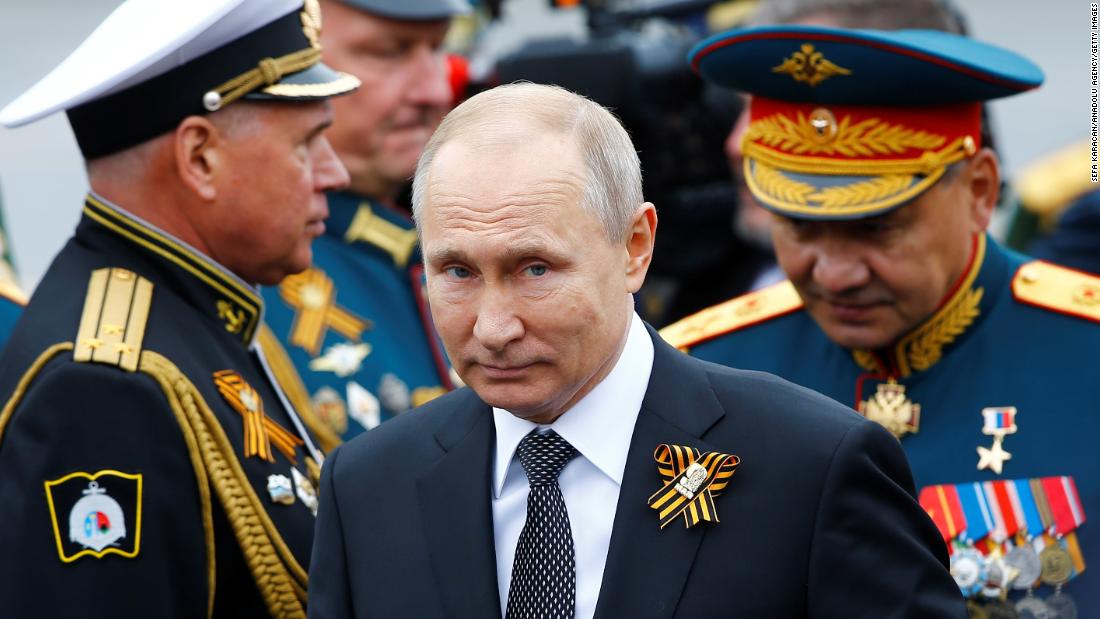
Choosing Peace in Ukraine, Not Ashes and Blood
(May 5, 2022) — “America stands with Ukraine until victory is won,” House Speaker Nancy Pelosi declared on May 1, after traveling to Kyiv for a meeting with Ukrainian President Volodymyr Zelensky. Victory? What exactly does Pelosi mean by “victory”?
Does that entail the total defeat of Russian forces and their expulsion from all of Ukraine? That can only be accomplished through the participation of US and NATO forces—a scenario that would almost certainly result in a Europe-wide war, with an attendant risk of nuclear escalation. Or does she mean a meat-grinder war aimed at weakening Russia to the point where it is no longer able to fight NATO, as suggested by Secretary of Defense Lloyd Austin after visiting Kyiv a few days earlier?
That might, conceivably, avert a nuclear war, but would surely result in hundreds of thousands of dead Ukrainian and Russian soldiers and civilians, and leave Ukraine itself in ruins. Nowhere, in her comments or those by other high-ranking US officials, is there any talk of a negotiated settlement in Ukraine, only of scenarios leading to Russia’s defeat, at whatever cost in human lives.
For Ukrainians, the desire to inflict pain on Russia is understandable: Their country has been invaded, their cities bombed, and many of their compatriots slain. It is also understandable why many in Europe, especially in the “frontline” states of Estonia, Latvia, Lithuania, and Poland, are keen to see Russia humbled, as they fear invasion themselves.
Elsewhere in Europe, and in this country, there is a natural instinct to favor the underdog in the Ukraine conflict, especially given the toll being imposed on civilians in Ukraine and widespread antipathy to Russian President Vladimir Putin.
This outlook seemed to govern US policy during the early days of the war. With Ukraine under attack from multiple directions and its vastly outnumbered army putting up heroic resistance around major cities, the Biden administration promised to rush the delivery of Javelin anti-tank missiles and other light defensive weapons. To further impair Russia’s war-making capacity, President Biden also imposed severe sanctions on key aspects of the Russian economy.
The prevailing image, during those early days of the war, was of a plucky but outgunned David fighting off a clumsy but savage Goliath—an image that attracted widespread sympathy around the world, no less than in this country. Congress was keen to speed the delivery of Javelins to the Ukrainians and to otherwise help David fend off Goliath. And, to the surprise of many on all sides, this combination of Ukrainian pluck and US weapons technology succeeded in blocking the Russian advance around Kyiv, forcing Goliath to withdraw.
This would have been the moment to initiate serious peace talks, leading to a halt in the fighting. A Ukrainian pledge to permanently forswear membership in NATO and grant limited autonomy to breakaway regions in the Donbas, combined with a Russian vow to withdraw its forces from the rest of the country, might have provided the basis for a cease-fire and then more formal negotiations on Ukraine’s long-term status. But aside from some ill-fated diplomacy by Presidents Emmanuel Macron of France and Recep Tayyip of Turkey, little effort was made to pursue this lifesaving course. Instead, both sides girded for a tougher, bloodier war.
For President Vladimir Putin of Russia, the reasons for this embrace of intensified fighting are no doubt complex. From all that can be determined, he entered the war believing that Ukrainian forces would capitulate after a few days of fighting and that the Ukrainian people—Russians at heart, he thought—would largely welcome their Russian “liberators.” When none of this occurred, and his much-vaunted army proved an immense disappointment, Putin seems to have taken it personally—as an affront to his strategic acumen—and so initiated a plan to seize eastern and southern Ukraine through sheer force of arms.
For US leaders, the motives for supporting an intensified Ukrainian drive to expel the Russians are somewhat more transparent: to strike a crushing blow on the Russian military, drastically reducing its threat to NATO and, conceivably, its loyalty to Vladimir Putin. “We want to see Russia weakened to the degree that it can’t do the kinds of things that it has done in invading Ukraine,”

Secretary Austin explained after meeting with Zelensky in Kyiv on March 24. This has required a very different sort of US aid effort from that undertaken at the start of the war: Instead of Javelins and other light, man-portable weapons, the United States and its allies are now supplying the Ukrainians with tanks, howitzers, and other heavy weapons intended to inflict severe damage on Russian armored columns.
In line with this approach, Biden asked Congress on April 28 for an additional $33 billion in aid for Ukraine—10 times the amount allocated for this purpose until now—with much of the additional funding to be used in supplying heavy weapons systems. “This assistance would provide even more artillery, armored vehicles, anti-armor systems, [and] anti-air capabilities that have been used so effectively thus far on the battlefield by the Ukrainian warriors,” he declared at the White House.
The Biden administration has also worked tirelessly to persuade the other NATO powers to supply Ukraine with weapons of this sort. On April 28, the day Biden announced that $33 billion aid package, Austin was in Germany, meeting with representatives of 40 US allies to coordinate the flow of such arms to Ukrainian forces. Significantly, Germany pledged to supply 50 armored anti-aircraft systems—the first time that country had agreed to provide Ukraine with heavy weapons. “Putin never imagined that the world would rally behind Ukraine so swiftly and surely,” Austin stated.
All this has substantially transformed the nature of the fighting in Ukraine, converting it from a rear-guard defensive action to a brutal slugfest between two major ground armies. At the very least, this will result in massive casualties on both sides, along with the destruction of any towns and cities in the zone of conflict. Even far more worrisome, it has become less of a Ukraine vs. Russia war and more of a US/NATO vs. Russia war—a shift that vastly increases the risk of a major-power conflagration and nuclear escalation.
Russian leaders have already warned that increased NATO weapons deliveries to Ukraine represent a strategic threat to their forces, obliging them to undertake appropriate countermeasures—for example by bombing Ukrainian arms depots located along the Polish border, a move that could easily lead to a direct clash with NATO forces and a wider war.
Senior officials, including President Putin and Foreign Minister Sergey Lavrov, have also warned that a major Russian reversal—one that posed a threat to the survival of the state—could result in the use of nuclear weapons. “The danger [of such use] is serious, real,” Lavrov declared on April 25, “and we must not underestimate it.”
None of this, however, seems to have diminished US leaders’ determination to increase the pressure on Russia and to keep raising it until Moscow capitulates—however illusionary this might seem. “The United States of America is in this to win, and we will stand with Ukraine until victory is won,” said Representative Jason Crow (D-Colo.) after accompanying Pelosi to Kyiv.
Under these circumstances, neither side has demonstrated any interest in conducting serious peace negotiations. It is likely, then, that the fighting will escalate, many more people will perish, and Ukraine’s cities, towns, and infrastructure will be pulverized.
But given the balance of forces on each side, it seems unlikely that either will ever be in a position to achieve “victory.” More likely, the fighting will grind on for weeks or months until both sides reach exhaustion—and then they will agree to a cease-fire in place and a negotiated outcome not too different from what might have been achieved in March, with far less bloodshed.
What is called for, then, is not illusionary promises of “victory” but rather a serious international effort to stop the fighting now, before more people perish, or the war escalates into something a whole lot worse. This will require a concerted effort by prominent figures with the authority to address the leaders on all sides—perhaps some combination of Presidents Macron of France, Erdogan of Turkey, and Xi Jinping of China.

They will have to devise an outcome that provides security assurances to all sides: a neutral Ukraine, a demilitarized Donbas, and some form of international backing for these arrangements.
To facilitate these efforts, moreover, the major actors should agree to engage in de-escalatory steps of various sorts: the suspension of nuclear threats by Russia and “victory” talk by Western leaders, the establishment of safe evacuation routes for civilians trapped in combat zones, provisions for the delivery of food and medical aid to civilians in besieged cities, and so on.
If we truly cared about the fate of Ukraine and its people, preventing further loss of life should be our highest priority. Let us heed the words of Tamara Mikheenko, a 70-year-old woman speaking by phone to a reporter from The New York Times from her embattled village in eastern Ukraine. Tell the presidents of Russia, Ukraine, and Russia to halt the fighting, she said. “Let them agree to stop this madness.”
Michael T. Klare, The Nation’s defense correspondent, is professor emeritus of peace and world-security studies at Hampshire College and senior visiting fellow at the Arms Control Association in Washington, D.C. Most recently, he is the author of All Hell Breaking Loose: The Pentagon’s Perspective on Climate Change.
Posted in accordance with Title 17, Section 107, US Code, for noncommercial, educational purposes.